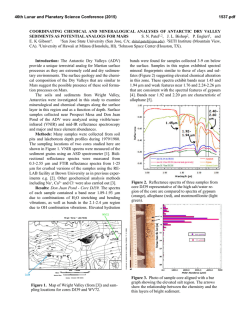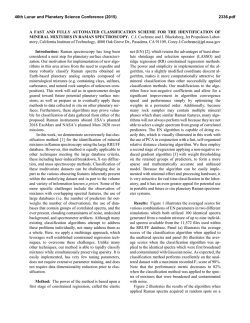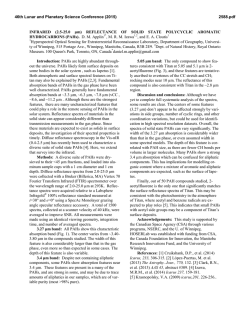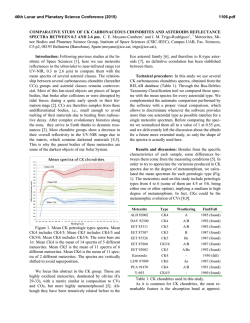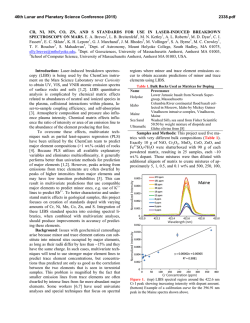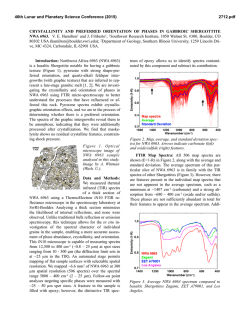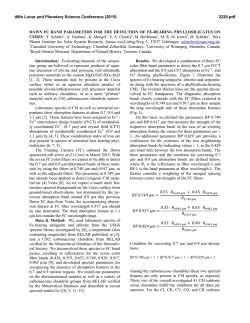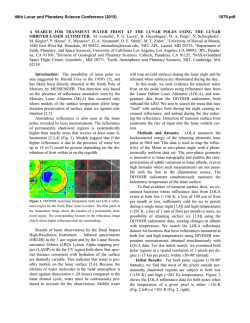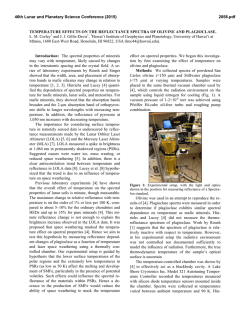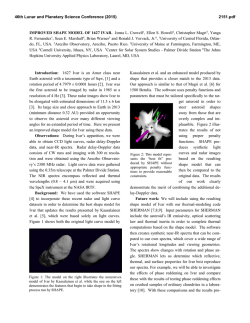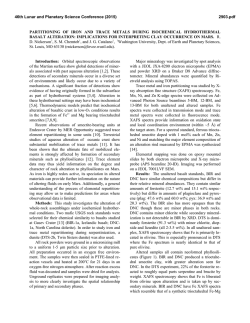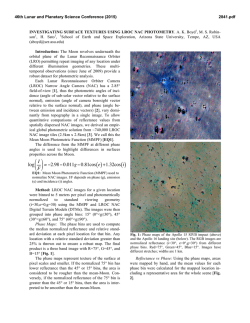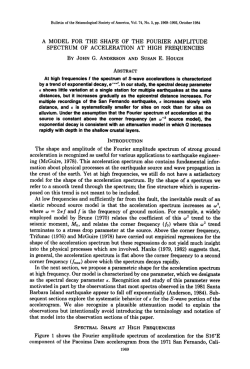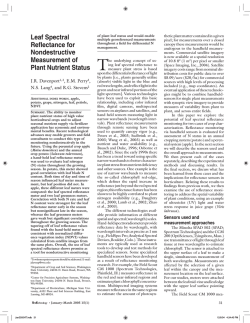
MID IR OPTICAL CONSTANTS OF TRICLINIC MINERALS: A CASE
46th Lunar and Planetary Science Conference (2015) 2902.pdf MID IR OPTICAL CONSTANTS OF TRICLINIC MINERALS: A CASE STUDY WITH LABRADORITE. M. J. Rucks1, J. A. Arnold2, and T. D. Glotch1. 1Stony Brook University ([email protected]), 2University of Oxford. Introduction: Plagioclase feldspars are common rock forming minerals found to be a major component of the surface geology of planetary bodies, such as Earth, the Moon, Mars, and some asteroids [1,2]. The composition of these minerals may give insight into the petrogenic history of these bodies. The wavelength-dependent complex index of refraction, 𝑛̃ = 𝑛 + 𝑖𝑘, is an essential input into radiative transfer models used to determine surface mineralogy of planetary bodies. The optical constants n and k, or the real and imaginary indices of refraction, are dependent upon both composition and crystal structure. The quantitative determination of surface mineralogy from mid-IR remote sensing data of planetary surfaces with finely particulate regoliths is limited due to a lack of sufficient optical constants of minerals belonging to the monoclinic and triclinic crystal systems. This is due to the increased complexity of modeling low symmetry constants as well as increased experimental complexity. There are currently only a few published sets of optical constants for minerals of monoclinic and triclinic symmetries [3-8]. Optical constants for plagioclase feldspar, which is a major triclinic rock-forming mineral, have not been determined previously for the reasons described above. Here we derive the optical constants for a gem-quality labradorite sample with an approximate composition of An65Ab34Or1. Background: Dispersion theory describes vibrational transitions that occur within a mineral as the summation of Lorenzian harmonic oscillators. Each oscillator can be described using with a set of parameters, ν, S, and γ, which are respectively, the center of frequency for the oscillation, the band strength, and the damping coefficient [3]. The complex dielectric tensor, 〈ε〉, which describes the vibrational transitions as a function of orientation and can be related to the complex index of refraction, and in turn n and k, as ñ2= ε [3]. The reflectance can be described as a function of n and k as shown in the equation below. (𝑛 − 1)2 + 𝑘 2 𝑅= (𝑛 + 1)2 + 𝑘 2 For minerals of orthorhombic and higher symmetry, the oscillations can be assumed to occur parallel to the principle axes. In such cases, the dielectric tensor can be diagonalized and measured oriented spectra are dependent upon only one of the diagonal elements. For triclinic minerals, the direction of the oscillations are arbitrary within the structure and change as a function of wavelength, increasing the difficulty with which values of n and k can be derived. In order to completely define the dielectric tensor, two angular terms (θ, φ) relative to crystallographic axes are considered, where θ is the oscillator axis angle with respect to the z axis and φ is the azimuth angle within the xy plane. The dielectric tensor, where εij=εji, can thusly be described using the following dispersion relations [6]: εxx = ε∞xx + ∑ Fj l2 j εxy = ε∞xy + ∑ Fj lj mj j j εyy = ε∞xx + ∑ Fj m2 j j εyz = ε∞yz + ∑ Fj Fj mj n εzz = ε∞zz + ∑ Fj n2 j j εzx = ε∞zx + ∑ Fj nj l where, Fj = j j Sj ν ν 2 1+iγ ( ) - ( ) νj νj lj =sinθj cosφj and mj =sinθj sinφj nj =cosθj Methods: The labradorite sample was oriented using single crystal XRD analysis of a thick section made from the sample. Three orthogonal faces were arbitrarily cut and polished to a 1 µm roughness, creating 3 faces whose edges were designated as x, y, and z. We collected reflectance spectra as outlined in [8] with the Nicolet 6700 FTIR spectrometer in Stony Brook University’s Vibrational Spectroscopy Laboratory using a FT-30 specular reflectance accessory with input and emergence angles of 30 degrees. Spectra were referenced to a first-surface gold mirror. For each face, two spectra were taken with the polarization direction parallel to each edge; two additional spectra were taken with the polarization direction along the diagonals of each face to improve the fit of ε. Each spectra was named according to a fixed laboratory coordinate system (X, Y, Z) and the direction of polarization (s, p). The resulting 12 spectra were fit simultaneously using a non-linear least squares fitting routine, lsqcurvefit available in Matlab. Initial values for the dispersion parameters were first found by modeling the spectra in the normal incidence case. These were then refined to obtain the final values for the parameters, as well as those of n and k. This model code is an adaption outlined in [7]. For a more complete description of the model please refer to Arnold. et al [this meeting] and [79]. Results: All reflectance spectra are shown in figures 1-3. Each spectra is named according to a fixed laboratory coordinate system (X, Y, Z) and the direction of polarization (s, p). Figure 4 shows a preliminary 46th Lunar and Planetary Science Conference (2015) 2902.pdf estimate of the n and k values for two of the refractive indices of labradorite. References:[1] Moroz et al. (2000) Icarus, 147, 7993. [2] Shkuratov et al. (2005) Solar Syst. Res., 39, 4, 255-266. [3] Aronson et al. (1983) Appl. Op., 22, 24, 4093-4098[4] Aronson et al. (1986) Spectrochim. Acta, 42A, 2/3, 187-190. [5] Aronson et al. (1985) Ap. Opt., 24, 8, 1200-1203. [6] Emsile A. G. and Aronson J. R. (1983) J. Opt. Soc. Am., 73, 7, 916-919. [7] Arnold et al. (2014) Am. Miner., 99, 1942-4955. [8] Hӧfer et al. (2013) Vib. Spect. 67. [9] Hӧfer et al. (2014) Vib. Spect. 72, 111-118.. Figure 3 Shows reflectance spectra taken parallel to the edges, Rs 0 90 0 and Rp 0 90 0, and along the diagonals, Rs 0 90 45 and Rp 0 90 45 of the y-z face. Figure 1 Shows reflectance spectra taken parallel to the edges, Rs 0 0 0 and Rp 0 0 0, and along the diagonals, Rs 45 0 0 and Rp 45 0 0 of the x-y face. Figure 4 Shows the initial calculations for two pairs of optical constants, n1 and n2, k1 and k2. Figure 2 Shows reflectance spectra taken parallel to the edges, Rs 90 90 90 and Rp 90 90 90, and along the diagonals, Rs 90 90 45 and Rp 90 90 45 of the x-z face.
© Copyright 2026
